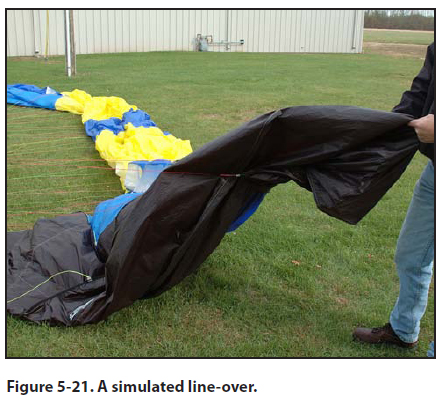|
Chapter 5 — Preflight and Ground Operations
Line-Overs
The line-over is one of the most dangerous things that
can happen to the powered parachute wing. A lineover
is exactly what it sounds like. Instead of the wing
line going straight from the wing to the riser system, it
takes a trip over the top of the wing first. This means
that when the wing inflates, the suspension line that is
over the top of the wing will pinch the wing together
and prevent the proper inflation of the wing to produce
the airfoil necessary to achieve flight. If a line is
over the top surface of the wing, the pilot risks serious
injury or death if takeoff is attempted. To recognize
a line-over before you take off, look for a line that is
twisted with other lines on one or both sides of the
wing. If you see that, your next step should be to inspect
the leading edge and top of the wing closely. If
you see a line wrapped over the top, you have found
your problem.
Sometimes using the “stacked” method of laying out
the wing during the final wing staging before flight
versus the “inverted” method can inadvertently produce
a line-over on the top side of the wing as it inflates.
Also, “stuffing” the wing into the wing bag
versus methodically folding the wing for storage can
cause a line to become wrapped around the top of the
wing mistakenly. [Figure 5-21]

To correct a line-over, pull the fabric of the wing
through the loop made by the line-over. To know
which side to pull the noncompliant suspension line
to, trace the line to its home line group (left or right
riser) before you start pulling things around. Sometimes
the side will be easy to determine because the
line-over is either close to the left or right edge of the wing. When it is not, tracing it is the best way to save
time and to determine the correct way to pull the wing
fabric.
Preparing for Takeoff
Wing inflation and kiting procedures are critical to a
successful takeoff. Refer to Chapter 7 for information
on how to lay out the wing, wing inflation, and
kiting.
After Landing
It is imperative to evaluate the field in which you intend
to land, particularly because of the unique nature
of the powered parachute wing, and what happens to
it prior to landing. If the field is being used by other
aircraft, taxi the powered parachute off the “active”
area or runway surface while the wing remains kited.
Ground taxiing with the wing kited takes a little practice,
but the flight instructor will make sure the student
pilot has adequately mastered this skill prior to
takeoff instruction.
After the powered parachute has touched down, release
the flare on the wing; this is done to prevent the
aircraft from becoming airborne again. Not releasing
the flare on landing is a critical and common mistake
made by both new and seasoned PPC pilots. With the
throttle at idle, the powered parachute begins to slow
down to the point where the stream of air is not sufficient
to maintain the wing’s pressurization. At this
time, the engine must be shut down immediately; the
consequences of not turning off the magnetos during
the after-landing roll are detrimental to the wellbeing
of the wing because the propeller will most
likely chop the PPC lines. A turning propeller and the wing and its components do not mix. Once you turn
off the magnetos, you will physically grab the steering
lines from overhead and pull the wing to the ground
to finish the deflation process. If the wing is allowed
to “float” down on its own, a small gust of wind can
force the suspension lines onto hot exhaust surfaces
which can melt the lines, or even pick up the cart and
instigate a landing roll.
|

